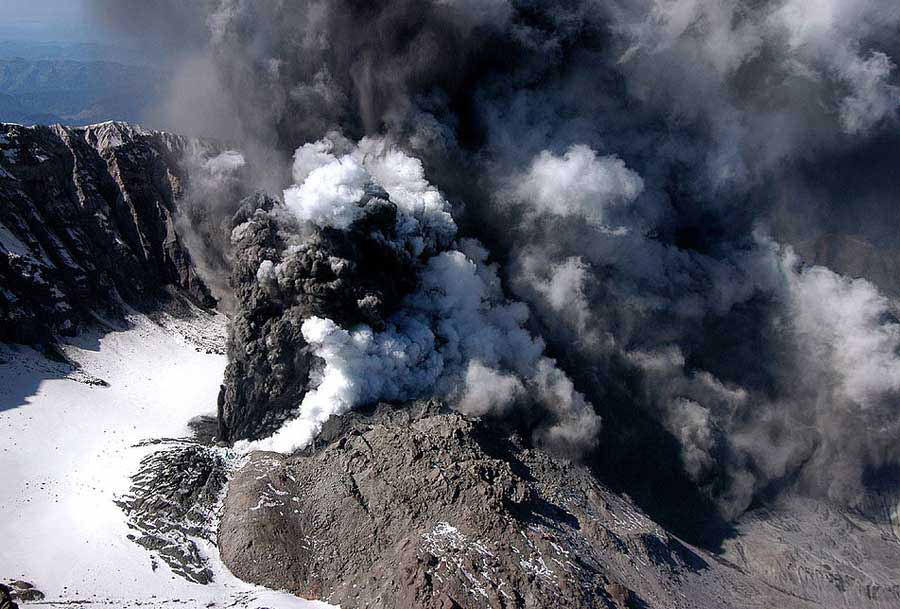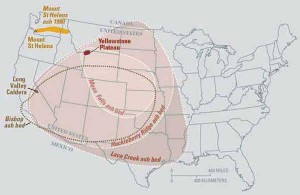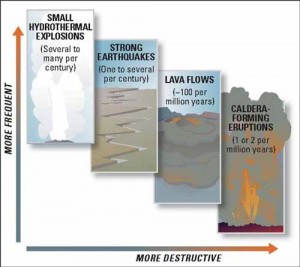
By Ruffin Prevost
CODY, WYO. — Gateway communities around Grand Teton and Yellowstone national parks benefit greatly from the parks’ millions of annual visitors, who spent more than $750 million in the region in 2010. But Cody and other Wyoming communities east of Yellowstone could miss out on an emerging economic development opportunity because of fears about volcanic activity in the park.
Wyoming Gov. Matt Mead has made it an economic development priority for the state to attract large-scale data centers like a planned $112 million cloud computing hub to be built in Cheyenne by software giant Microsoft Corp.
But a recent statewide assessment of Wyoming’s ability to attract and support such data centers found that some industry leaders are wary of locating facilities in the state’s northwestern corner, citing the risk of a volcanic eruption in Yellowstone Park.
“I’m sorry to say that could be a deciding factor for some,” said Joseph E. Sharkey, a vice president at TMNG Global, a telecommunications and technology consulting firm hired to assess the state’s infrastructure.

Jacob B. Lowenstern, the scientist in charge of the U.S. Geological Survey’s Yellowstone Volcano Observatory, said it would be a mistake for businesses to focus on a potential eruption in Yellowstone as a prohibitive risk for any major infrastructure project.
Sharkey delivered a report to the Wyoming Business Council on the state’s fiber optic telecommunications and electric power infrastructure to help determine which towns might be a good fit for companies looking to build data centers.
Sean Stevens, business recruitment manager for the Wyoming Business Council, did not respond to a message seeking comment.
Like many places across much of Wyoming, Cody has a lot of things data centers look for in a host city, including relatively affordable electric power and low summer temperatures, which make it cheaper to cool the massive complexes.
Cody’s Buffalo Bill Dam even produces hydroelectric power, a likely selling point for any company looking to enhance its environmental image.
“A lot of companies would like to be able to brag that they’re on clean energy from a hydroelectric plant,” Sharkey said last month when discussing Cody’s potential as a data center location during a wide-ranging presentation to state business leaders.
Yellowstone volcano risk
But the risk of an eruption in Yellowstone — large or small — is clearly on the radar for some decision-makers, Sharkey said this week in a follow-up interview.
Site analysts focus not just on the immediate and nearby explosive destruction that might be caused by a major eruption, “but also the typical ash pattern based on prevailing winds” from a lesser event, he said.
“That wind effect takes you directly across Cody and the northern part of the state and up into Montana and Canada. The concern is not just that you have a catastrophic explosion, but if there is any type of ash pattern,” Sharkey said.
Major companies ranging from financial institutions to Internet giants to entertainment companies have sought to build new facilities in isolated, low-risk areas ever since the terrorist attacks of 9/11 caused severe disruptions in data centers based in New York City, he said.
Data center underwriters have paid especially close attention to volcanoes as a risk factor since an April 2010 eruption in Iceland made international headlines. Flights across Europe were grounded as a precaution over fears that the fine abrasive grains of volcanic ash could damage plane engines. Analysts worry that same ash could cause power or communications disruptions and wreck cooling and ventilation systems.
Major data center projects being developed in Iceland at the time of the eruption there have since faced an uphill battle attracting clients, Sharkey said.

Whether the risks are high, grossly overblown or somewhere in between, much is at stake for communities like Cody, including dozens of jobs and millions of dollars.
Sharkey made a final recommendation last year to client Verizon Communications to locate a planned 900,000-square-foot, $500 million data center in Laramie, Wyo., despite some internal discussion of the Yellowstone volcano risk.
That project ended up being shelved after Verizon spent $1.4 billion to acquire Terremark, a cloud hosting provider with excess capacity. But even when Verizon was considering investing billions over 20 years into what would have been one of the world’s largest data centers in Laramie, the Yellowstone volcano was not a deal-killer, Sharkey said.
“The Verizon comment was that if Yellowstone (erupted) the way it’s predicted on Discovery Channel, the country will have bigger issues than Verizon losing their data center,” Sharkey said.
Lowenstern agreed, saying that “it’s such an unlikely event having a super-eruption at Yellowstone that would severely affect Cody, that the loss of a data center is going to be within the noise” of much larger crises resulting from the event.
Even the likelihood of a smaller eruption that might produce heavy ash across Cody and nearby areas was still relatively small compared to the risk to infrastructure elsewhere from natural disasters like tornadoes, Lowenstern said.
Such concerns about the Yellowstone volcano — even carried 100 years into the future, when current data center technology is likely to be obsolete — are based on a risk that is “very low, and to my mind, shouldn’t be part of an economic decision of where to site some useful infrastructure,” he said.
Despite concerns by some in the industry, Cody and other northern Wyoming communities might still be able to attract data centers, especially if a key decision maker is sold on the local quality of life, Sharkey said.
“For instance, the guy that comes there and decides it’s the greatest fishing ever — for the right client, building a data center there should be still very reasonable,” he said.
Contact Ruffin Prevost at 307-213-9818 or [email protected].

Hi Ruffin,
Good article. I have spent considerable time with Joe and find that data centers do have a role in Cody’s economic future, just not to the level they may in other parts of the state.
The supervolcano issue has little to do with that. It has a lot more to do with the fact that no less than 10 major fiber pipes parallel I-80. Data centers live and breath on the certainty of connection. Both Joe and I have laughed about the idea that if the supervolcano event happens, data will be the least of our worries in the US. FYI- we actually have two potential small centers looking at locations in the area.
Is this serious ? Really…worrying about a remotely possible supervolcano event that would like give months if not years of warning and precede incrementally , versus the immense concentration of fiber optics and data centers in Silicon Valley and elsewhere in Pan-San Andreas California on top of a tapestry of active fault zones and the very real possibility of the mag 9 Big One coming any day now… ? By the way , Redmond Washington , home to Microsoft , and metro Seattle are in the probable blast zone of both Mt. Rainier and Mt. Baker when they blow.
SIDEBAR: funny that the hydro plant at Buffalo Bill Dam is mentioned as an incentive for ” green” power. Those turbines running full out can’t even produce enough power to run existing Cody. The City of Cody via its co-op WMPA buys its power from a very VERY dirty coal-fired plant near Wheatland, and recently that same co-op initiated a new coal-plant that isn’t much better. Brown energy .